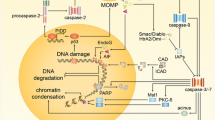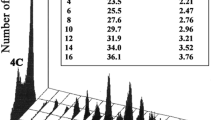Abstract
Programmed cell death is activated, by different stimuli and in many cell types, to regulate cell population balance during tissue proliferation and embryogenesis. Its initial event seems to be, in most cases, the activation of a Ca2+-dependent endonuclease, causing DNA cleavage into nucleosomic fragments. Its morphological expression is characterized by deep nuclear changes, consisting of typical cap-shaped chromatin marginations, followed by nuclear fragmentation and final formation of numerous micronuclei. Cytoplasmic damage appears in a very late stage of the process and the greatest part of the phenomenon appears to take place despite good preservation of the plasma membrane and organellar component. In the present study we analyzed apoptosis in camptothecin-treated HL60 leukaemia cells, and in freshly isolated mouse thymocytes treated with dexamethasone. The process was first quantified and time monitored by flow cytometry. Subsequently the specimens were processed for morphological examination in order to investigate the behaviour of the different nuclear domains. To follow DNA and RNA localization, we utilized osmium ammine and DNase-colloidal gold cytochemical reactions. The concentration of most DNA in the cap-shaped structures was demonstrated by these reactions. Confocal microscopy of cells processed by in situ nick-translation suggested that DNA was firstly cleaved and subsequently condensed in cup-shaped structures. Despite the strong nuclear modifications, nucleoli could be clearly recognized until the late apoptotic stages.
Similar content being viewed by others
References
Adolph F, Hameister H (1985) In situ nick translation of metaphase chromosomes with biotin-labelled dUTP. Hum Genet 69:117–121
Altman LG, Schneider BG, Papermaster DS (1984) Rapid embedding of tissues in Lowicryl K4M for immunoelectron microscopy. J Histochem Cytochem 32:1217–1223
Arends MJ, Morris RG, Wyllie AH (1990) Apoptosis: the role of the endonuclease. Am J Pathol 136:593–608
Arends MJ, Wyllie AH (1991) Apoptosis: mechanisms and roles in pathology. Int Rev Exp Pathol 32:223–254
Bendayan M (1981) Ultrastructural localization of nucleic acids by the use of enzyme-gold complexes. J Histochem Cytochem 29:531–541
Bendayan M (1982) Ultrastructural localization of nucleic acids by the use of enzyme-gold complexes: influence of fixation and embedding. Biol Cell 43:153–156
Berger S, Schweiger HG (1986) Perinuclear dense bodies: characterization as DNA-containing structures using enzyme-gold granules. J Cell Sci 80:1–11
Darzynkiewicz Z, Bruno S, Del Bino G, Gorczyca W, Hots MA, Lassota P, Traganos F (1992) Features of apoptotic cells measured by flow cytometry. Cytometry 13:795–808
De la Torre J, Sumner AT, Gosalvez J, Stuppia L (1992) The distribution of genes on human chromosomes as studied by in situ nick translation. Genome 35:890–893
Derenzini M, Farabegoli F (1990) Selective staining of nucleic acids by osmium-ammine complex in thin sections from Lowicryl-embedded samples. J Histochem Cytochem 38:1495–1501
Derenzini M, Viron A, Puvion-Dutilleul F (1982) The Feulgen-like osmium -ammine reaction as a tool to investigate chromatin structure in thin sections. J Ultrastruct Res 80:133–147
Ellis EE, Yuan J, Horvitz HR (1991) Mechanism and functions of cell death. Annu Rev Cell Biol 7:663–698
Falcieri E, Gobbi P, Sabatelli P, Santi S, Farabegoli F, Rana R, Cataldi A, Maraldi NM, Martelli AM (1992) A combined ultrastructural approach of the study of nuclear matrix thermal stabilization. Histochemistry 98:121–129
Falcieri E, Martelli AM, Bareggi R, Cataldi A, Cocco L (1993) The protein kinase inhibitor staurosporine induces morphological changes typical of apoptosis in Molt-4 cells without concomitant DNA fragmentation. Biochem Biophys Res Commun 193:19–25
Farabegoli F, Govoni M, Novello F (1992) Effects of camptothecin, an inhibitor of DNA topoisomerase I on ribosomal gene structure and function in TG cells. Biol Cell 74:281–286
Fesus L, Davies PJA, Piacentini M (1991) Apoptosis: molecular mechanisms in programmed cell death. Eur J Cell Biol 56:170–177
Gajkowska B, Puvion E, Bernhard W (1977) Unusual perinucleolar accumulation of ribonucleoprotein granules induced by camptothecin in isolated liver cells. J Ultrastruct Res 60:335–347
Gavrieli Y, Sherman Y, Ben-Sasson SA (1992) Identification of programmed cell death in situ via specific labeling of nuclear DNA fragmentation. J Cell Biol 119:493–501
He D, Nickerson JA, Penman S (1990) Core filaments of the nuclear matrix. J Cell Biol 110:569–580
Kaufmann SH (1989) Induction of endonucleolytic DNA cleavage in human acute myelogenous leukemia cells by etoposide, camptothecin, and other cytotoxic anticancer drugs: a cautionary note. Cancer Res 49:5870–5878
Oberhammer F, Fritsch G, Schmied M, Pavelka M, Printz D, Purchio D, Lassmann H, Schulte-Hermann R (1993a) Condensation of the chromatin at the membrane of an apoptotic nucleus is not associated with activation of an endonuclease. J Cell Sci 104:317–326
Oberhammer F, Wilson JW, Dive C, Morris ID, Hickman JA, Wakeling AE, Walker PR, Sikorska M (1993b) Apoptotic death in epithelial cells: cleavage of DNA to 300 and/or 50 kb fragments prior to or in absence of internucleosomal fragmentation. EMBO J 12:3679–3684
Recher L, Chan H, Briggs L, Parry N (1972) Ultrastructural changes inducible with the plant alkaloid camptothecin. Cancer Res 32:2495–2501
Savill JS, Wyllie AH, Henson JE, Walport MJ, Henson PM, Haslett C (1989) Macrophage phagocytosis of aging neutrophils in inflammation. J Clin Invest 83:865–875
Sgonc R, Boeck G, Dietrich H, Gruber J, Recheis H, Wick G (1994) Simultaneous determination of cell surface antigens and apoptosis. Trends Genet 10:41–42
Ucker DS, Obermiller PS, Eckhart W, Apgar JR, Berger NA, Meyers J (1992) Genome digestion is a dispensable consequence of physiological cell death mediated by cytotoxic T lymphocytes. Mol Cell Biol 12:3060–3069
Verheijen R, Van Venroij W, Ramaekers F (1988) The nuclear matrix: structure and composition. J Cell Sci 90:11–36
Vitale M, Zamai L, Mazzotti G, Cataldi A, Falcieri E (1993) Differential kinetic of propidium iodide uptake in apoptotic and necrotic thymocytes. Histochemistry 100:223–229
Wyllie AH, Kerr JFR, Currie AR (1980) Cell death: the significance of apoptosis. Int Rev Cytol 68:251–306
Zamai L, Falcieri E, Zauli G, Cataldi A, Vitale M (1993) The optimal detection of apoptosis by flow cytometry depends on cell morphology. Cytometry 14:891–897
Zini N, Mazzotti G, Santi P, Rizzoli R, Galanzi A, Rana R, Maraldi NM (1989) Cytochemical localization of DNA loop attachment sites to the nuclear lamina and to the inner nuclear matrix. Histochemistry 91:199–204
Zychlinsky A, Prevost MC, Sansonetti PJ (1992) Shigella flexneri induces apoptosis in infected macrophages. Nature 358:167–169
Author information
Authors and Affiliations
Rights and permissions
About this article
Cite this article
Cataldi, A., Cinti, C., Santi, S. et al. The behaviour of nuclear domains in the course of apoptosis. Histochemistry 102, 221–231 (1994). https://doi.org/10.1007/BF00268899
Accepted:
Issue Date:
DOI: https://doi.org/10.1007/BF00268899




